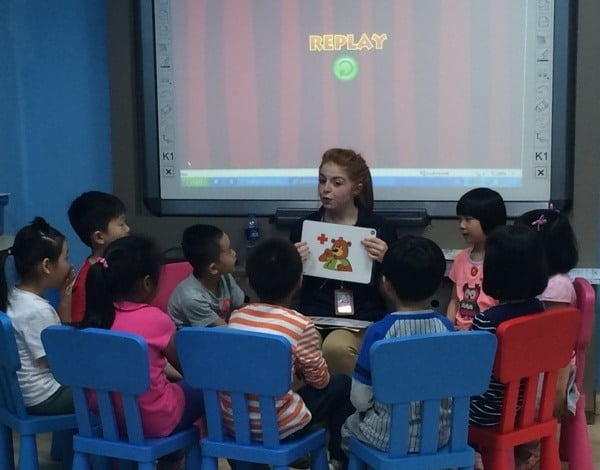Classroom Management
The definition of classroom management is disputed by academics and teachers throughout the world. However, in general, classroom management can be classified as a method to ensure that time spent teaching and learning in the classroom is maximised and time lost due to disruptive behaviours is minimised. This can be achieved through effective planning, control or preventative processes.
The British Council define the term as, “The ability to plan, control and facilitate interaction in the classroom that is appropriate to the activity and promotes learning and takes into account different needs and abilities of learners.” Further to this, some academics believe that in order to create an environment which is in line with academic and social–emotional learning, the teacher must be aware of several factors. Teachers should strive for a healthy relationship and strong rapport with their students and enforce positive relationships between students in the class.
Classroom management is undoubtedly important in the classroom and according to the British Council, “It enables the teacher to manage energy levels, ensure appropriate learner participation, and create working patterns that have a positive impact on learning. It helps to motivate learners and ensures that different styles of learning are catered for and different needs met.”
Why Classroom Management is Important
While planning classes, most teachers aim to optimise teaching time in the classroom which consists of maximising time spent learning and minimising time spent on disruptions which could impact on student learning time. This is inherently linked to effective classroom management strategies, including ensuring that students are following clear instructions set by the teacher and that they are engaged in tasks.
A further aim of the teacher should be to develop student confidence and improve interpersonal skills, learners with behaviour problems should be supported and preventative methods should be enforced. This should be applied in a classroom with a positive atmosphere where the rules are very clear to learners and a place where clear routines are established. These goals can be achieved with effective classroom management.
The Old Fashioned Way
 Classroom management is an aspect of teaching that most teachers have struggled with at one point in their career. Once a teacher is unable to control a class, it can be extremely difficult for control to be restored. There have been several disciplinary techniques used throughout history, perhaps the most infamous of these being corporal punishment. Corporal punishment in an educational setting is defined as the physical punishment of students which inflicts pain as a penalty for bad behaviour in the classroom. This was used to control classes although it is considered by some as scare tactics, which does not encourage respect or mutual understanding in the classroom. This method is no longer considered acceptable in schools. This form of discipline has been banned in schools in many countries around the world.
Classroom management is an aspect of teaching that most teachers have struggled with at one point in their career. Once a teacher is unable to control a class, it can be extremely difficult for control to be restored. There have been several disciplinary techniques used throughout history, perhaps the most infamous of these being corporal punishment. Corporal punishment in an educational setting is defined as the physical punishment of students which inflicts pain as a penalty for bad behaviour in the classroom. This was used to control classes although it is considered by some as scare tactics, which does not encourage respect or mutual understanding in the classroom. This method is no longer considered acceptable in schools. This form of discipline has been banned in schools in many countries around the world.
Another somewhat old fashioned technique used in classrooms is ‘rote discipline’. This is the process of giving students a sentence to write repeatedly, usually in relation to the negative behaviour exhibited by the student. This form of discipline features in the TV show ‘The Simpsons’ during the opening credits.
Creating a Positive Classroom Environment
While corporal punishment and rote discipline are considered punishment for bad behaviour, some academics argue that preventative methods are more effective that punishing negative classroom behaviours.
Affirmation teaching is a method which aims to show students that their own success comes as a result of their efforts in the classroom. It guides students towards a mind-set where they are intrinsically motivated and want to perform well. Eventually, this method should lead to a class of students who are well behaved and self-motivated.
Ideally, learners will be intrinsically motivated and will take responsibility for their own learning and be self-disciplined. This will reduce stress for both learner and teacher and remove the need for punishments or rewards. This method does not rely on external sources for reinforcement.
Preventative methods can also include the creation of a positive classroom environment where respect exists between the teacher and students. Facilitators using these methods do not use scare tactics and instead offer a fair and friendly approach to students in class. The rules should be established at the beginning of the course undertaken by students. This can be in the form of a contract, created by students and the teacher. Both parties agree on acceptable behaviour from both the teacher and the students and then sign the contract which states their consent and agreement of the consequences if the rules are broken. Teachers using this method give students regular feedback on their behaviour in class.
Understanding the Root Cause
In an attempt to manage student behaviour, the problem can often be made worse. In the classroom, most teachers only see the ‘tip of the iceberg’. Bad behaviour or lack of interest from students, are often just the symptoms of underlying problems. It is important that teachers understand that there are often reasons as to why students are behaving in this way. Issues may include problems at public school or bullying in the EF classroom (which teachers not speaking the local language may not be aware of). There may be external pressures from parents or the student may be struggling with the level of the class, causing them to act in a disruptive manner.
Foreign teachers at EF should be aware of cultural differences in classrooms between China and their home country. A lack of understanding of cultural differences can increase the difficulty of classroom management. Behaviours and expectations in performance stem from and vary with culture. As long as teachers can recognise the differences between their own culture and the culture of the students, classroom management should not prove more difficult than in the teacher’s home country.
The Benefit of Clear Rules
Teachers are mostly free to create their own rules and define what they think is appropriate behaviour in the classroom. Rules should be clearly defined and reinforced regularly. The rules of the classroom can be drilled at the start of every class and it is helpful to have a corresponding action for each, in order to help students remember.
Some of the most common rules in EF classrooms are:
1. Speak English only, do not speak Chinese!
2. Pay attention when the teacher is talking.
3. Sit properly in your seat.
4. Be prepared for class –bring your book(s), homework and stationery items.
5. Do not interrupt the teacher or shout in class – raise your hand to talk.
6. Do not eat or drink in class without asking the teacher.
Teachers should ensure that consequences and expectations do not vary from student to student or with time, so that students understand that the rules will be enforced consistently.
However, it should be noted that one approach will not work for all children. Teachers should be aware of this and be ready to use different classroom management techniques when necessary. Teachers should not allow themselves to react emotionally or negatively when a method does not work and should instead try a different approach. Some classroom management techniques available for teachers, among many, are listed below:
1. Split the students into two teams, award points to teams for good answers and behaviour. Deduct points from teams for speaking in Chinese or other misbehaviour. A competitive atmosphere in the classroom will encourage disruptive students to behave well due to pressure from their teammates.
2. Divide a piece of paper in half; one half for good behaviour and one half for bad. When a student misbehaves, write their name on the ‘bad’ half with a brief description of their misbehaviour. When a student participates or performs well, write their name on the ‘good’ half. Explain to the students that if their name appears on the bad side more often than it is on the good side, there will be consequences. The teacher should decide on an appropriate punishment such as extra homework or talking to the students’ parents.
3. Explain to the class that if anyone does anything naughty the first letter of their name will be written on the board. If their whole name is written on the board at the end of the class there will be a punishment, chosen by the teacher. Good behaviour will result in letters of their name being erased from the board, enabling students to redeem themselves.
4. Another effective classroom management technique is the use of technology in class, namely the website ‘Class Dojo’ (found at http://www.classdojo.com and also available in the app store). This website allows teachers to create a class where each student is allocated an avatar. Students are rewarded points for a variety of good behaviours (teachers are able to add their own) and deducted points for bad behaviour. This can be shown on the board during the class so that students are able to see and judge their performance and also compete with their classmates. The website gathers and records data over time and can be shown to parents if necessary.
5. Quiet signals are another classroom management technique which can help teachers regain control of a disruptive class. A signal can minimise class time spent on corrective procedures including preventing the need for teachers to raise their voice to the students. An example of this is the teacher raising their hand, which signals to the class that they should stop talking and pay attention.
6. Another technique is for the teacher to count down from 5 using their fingers to show the numbers while they count. This technique is effective as the majority of learners are able to count to 5 in English and are able to understand that when the teacher reaches ‘1’ they should be quiet and pay attention.
7. For an ESL teaching environment it is beneficial and more effective to include audio, visual and kinaesthetic approaches in a signal. An example of this is a clapping signal, the teacher should clap a pattern which the students should replicate and clap back to the teacher. This signals to the students that they should be quiet and listen to the teacher. It includes different learning approaches which increases the rate of success. The sound and movement will capture the attention of most students in the class. This technique is not reliant on a particular level of English and can be used in classes of very young learners up to teenagers.
A Well Behaved Class is an Effective Class
There are a variety of classroom management apps available for iPhone and iPad which are designed to help teachers control classes and prevent disruptive behaviour by guiding them through the processes involved in managing classroom behaviour.
Classroom management is an essential part of teaching and with sound methods in place, both teachers and students will benefit. If the importance of classroom management is understood by teachers and methods are implemented correctly, learning time in the classroom will be maximised. Effective classroom management will result in more engaged students and a positive atmosphere in the classroom for both teacher and students alike.

















Well done Amy!
These are really great tips fpr classroom management. I’ve generally tried all of them, except for the application. Still, some classes are disbehaving a lot. Could it be the lack of communication with students, or no proper bonding? Some of the students start behaving well only after the Chinese teacher comes back to the classroom.